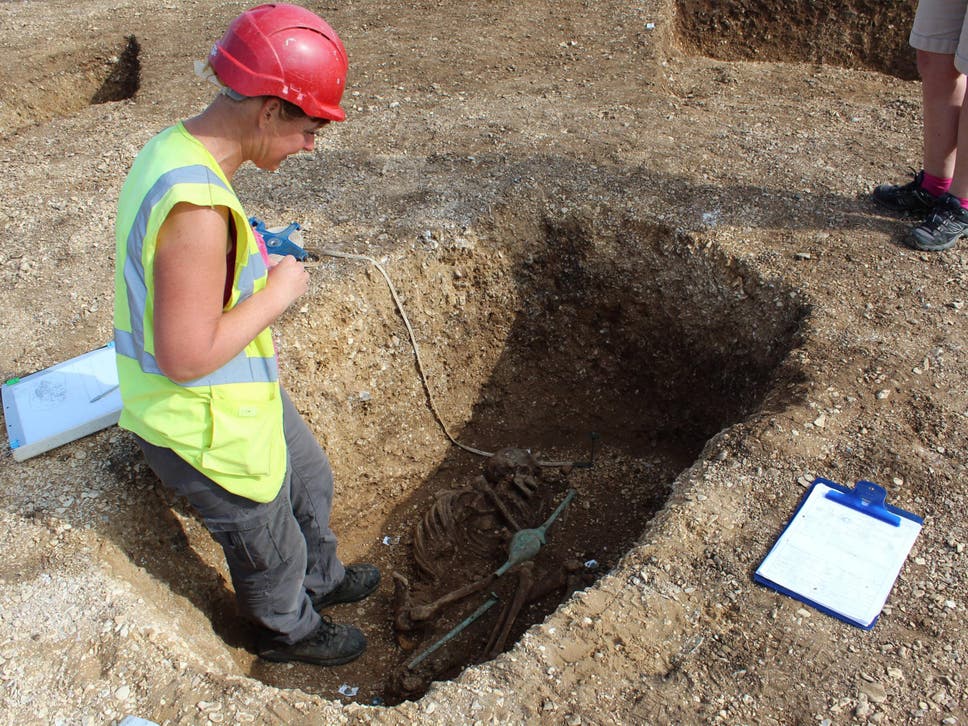Vampire-killing ritual could explain prehistoric skeletons found in Yorkshire
Exclusive: Chariot with remains of two ponies also unearthed in ‘remarkable’ Iron Age graves
David Keys Archaeology Correspondent @davidmkeys

The excavation of the remains of a speared Iron Age man near Pocklington, Yorkshire
The excavation of the remains of a speared Iron Age man near Pocklington, Yorkshire ( David Keys )
Two of the most bizarre prehistoric human burials ever found in Britain have been discovered by archaeologists in Yorkshire.
Excavations near the town of Pocklington have unearthed a pair of mysterious 3rd century BC Iron Age graves containing the skeletons of potentially high status individuals whose dispatch to the next world had featured some very unusual rituals, including possible vampire-killing ones.
The archaeological investigation has revealed that one individual – a warrior aged between 17 and 25 – may have been “killed” twice, or even three times.
'Vampire' discovered buried in Cemetery of Children in Italy
A detailed examination of his skeleton shows that, probably after his death, his body had been ritually pierced by nine spears (five with iron tips and four with bone ones). He had also received a potentially lethal blow to his forehead, delivered with a wooden club or other similar weapon.
But as yet, it is unknown as to precisely why his corpse was attacked in this way.
TOP ARTICLES
2/6
READ MORE
Brexit news - live: Leo Varadkar warns Theresa
May not to renege on promises over Irish backstop to win over Conservative rebels
One potential explanation is that, although he was a respected warrior, he had died of natural causes, and not in battle. Perhaps significantly his shield had been deliberately dismantled. But the ritual spearing of his corpse might have allowed him the privilege of finally dying a warrior’s death.
Two Iron Age graves discovered in Yorkshire
Show all 3
A second possibility could be that, at least after death, he was feared. In many parts of the world there is archaeological and folklore evidence for a tradition in which some corpses (those of suspected “vampires” and other “revenants”) were systematically speared by sharp objects (usually of metal or wood) to “neutralise” them.
What’s more, as in the Pocklington case, the metal or other objects used to pierce the corpse were usually not withdrawn from the dead body, but were left there – in effect, for eternity.
A third possibility is the individual was put in the ground alive and then ritually murdered. Certainly there are other Iron Age examples of ritual murder – particularly in the case of so-called bog bodies.
This particular individual was not buried in a bog, but could potentially still have been be a victim of ritual murder. The fact he had received a potentially very deliberate blow to his forehead could be seen as consistent with this explanation.
Read more
Iron Age chariot and horse found buried together in Yorkshire
The Pocklington speared-corpse burial is not the first to be found in Britain – but it is one of the most complete. Over recent decades, at least 14 other examples have come to light in Yorkshire (mostly with between four and 15 spear piercings each).
However, only detailed further research will stand a chance of finally solving the riddle of this extraordinary human interment.
Perhaps significantly, a woman, also aged between 17 and 25 (and suffering from spina bifida), had been interred as a secondary burial immediately adjacent to the burial mound (potentially immediately after its construction). Her relationship to the speared man is not known – but scientists will be investigating to determine whether she might have been his sister.
The second mystery burial unearthed near Pocklington (just 55 metres away from the first) is almost equally bizarre.
The deceased – an elderly man, probably in his sixties or seventies – was buried in his chariot along with the two mature ponies that had once pulled it.
Read more
Ancient plague may have wiped out Stone Age farmers in Europe
Museum ordered to return 2000-year-old Greek statue by Supreme Court
Scientists rethink human evolution after discovery of ancient tools
However, it is likely the animals were put in the grave alive and then yoked to the chariot, as if in motion. It appears the grave was then filled up with earth around the two live ponies, the chariot and the dead man.
Probably when there was sufficient earth in the grave to prevent the animals from moving, they were killed and decapitated. Their heads were then removed from the grave, perhaps even to “stand guard” outside the mound that was then constructed over the elaborate burial.
The archaeological evidence shows the man was sent off to the next world, not only in his chariot pulled by his still-standing ponies, but fully clothed and wearing a fine bronze brooch.
He was lying in a foetal position on his highly decorated 35cm diameter bronze, wood and leather shield and surrounded by the bones of six piglets, whose flesh had almost certainly been devoured during the man’s funeral feast.
Support free-thinking journalism and subscribe to Independent Minds
The excavations were directed by archaeologist Paula Ware of the Yorkshire-based heritage company, the MAP Archaeological Practice, and was funded by Persimmon Homes Yorkshire, a developer which is building 200 houses on the site.
The chariot burial excavation will be featured in the archaeological TV programme, Digging for Britain, on BBC Four on 19 December.
“The excavation of these burials has only been the start of our investigation. Hopefully, our scientific tests programme over the coming months will shed more light on these two remarkable sites,” said Ms Ware.
https://www.independent.co.uk/news/science/archaeology/iron-age-burial-yorkshire-chariot-grave-skeleton-warrior-archaeology-dig-pocklington-a8672331.html